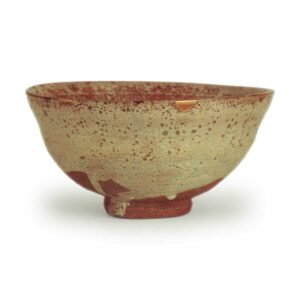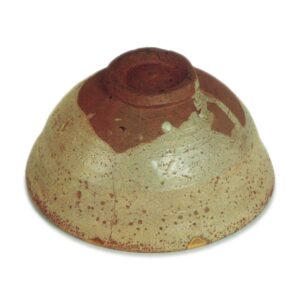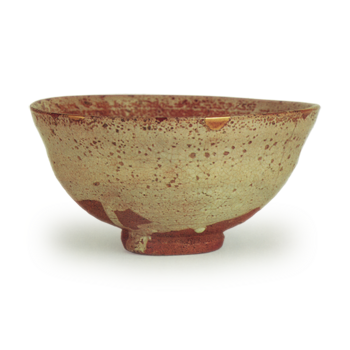

Height: 7.4 – 8.9 cm
Diameter: 15.3 cm
Foot diameter: 5.2 – 5.3 cm
Height to rim: 1.0 cm
It is called Keiya Karatsu because it was owned by Itoya Ryosai (also written as Ryosai), a tea master of the Enshu school and a connoisseur of great renown in Kyoto during the Genroku period.
From what I hear, it has been prized by tea ceremony enthusiasts as one of the three Karatsu bowls, along with the Nakao and Kashu, since some time in the past.
The Yuki is a rare example of an old Karatsu bowl with a beautiful glaze, and it is a large bowl with a full, substantial shape and a friendly, approachable feel. The foot is quite small and tight compared to the diameter of the bowl, and it has a distinct bamboo-like texture. The foot to the body of the bowl is carried out while maintaining a gentle curve, and the upper part of the body tapers off to the rim, with a slightly inverted rim.
The foot ring is clearly defined because the foot ring was scraped quite deeply, and the waist scraper extends to the body area. The foot ring is thin and flat, and a helmet-shaped pattern appears in the center of the interior, with two or three thin lines circling around it. In addition, there is a large hole where the stone was removed from the tatami mat.
The unglazed area from the foot to the foot ring shows a sticky grayish-brown clay surface, and the inside of the foot ring shows a reddish hue tinged with vermilion.
The white-gray glaze has a slightly rough crackle, but the glaze is quite thick overall.
The glaze is quite rich, and the outside is particularly vivid. The area near the foot of the vessel is slightly bluish, or it changes to pink or yellowish red, and the two streaks of glaze that overlap at the foot of the vessel and form a bead on the side of the foot are also a highlight.
On the inside of the glaze, there are large and small spots that look like rain leaking in, and there is a little sesame seed sprinkled around the tea pool. There is a tea stain around the rim.
The reason it is a little heavy to pick up is because the waist is quite thick, but the shape is similar to the Kokan Karatsu “Sanpo”. However, while the Sanpo has a very deep wabi-sabi feel, this tea bowl has a bright glaze color, and I think it is probably not just me who thinks that this tea bowl is suitable for thick tea in the first Furo.
There is a crack running from the mouth to the body, and there are ten small loose spots around the rim, all of which have been repaired with gold.
As this is a famous bowl that has not been seen for a long time, it will surely increase in value among tea ceremony enthusiasts.
On the inside of the black lacquered box, the words “Itoya Karatsu” are written in silver powder, although the author is unknown. On the inside of the outer box, the words “This tea bowl was originally owned by Ryo Sai of Itoya, and is called Itoya Karatsu” are written.
Although we do not know the exact age of the tea bowl, we have heard that it was passed down to the Fukui family in Kyoto after Itoya.



